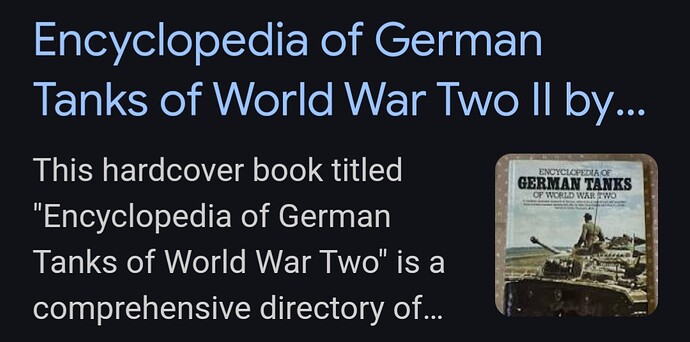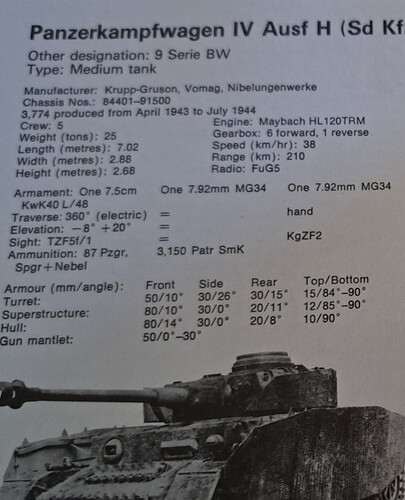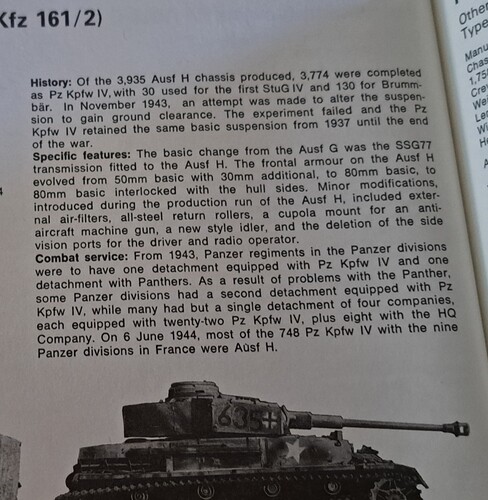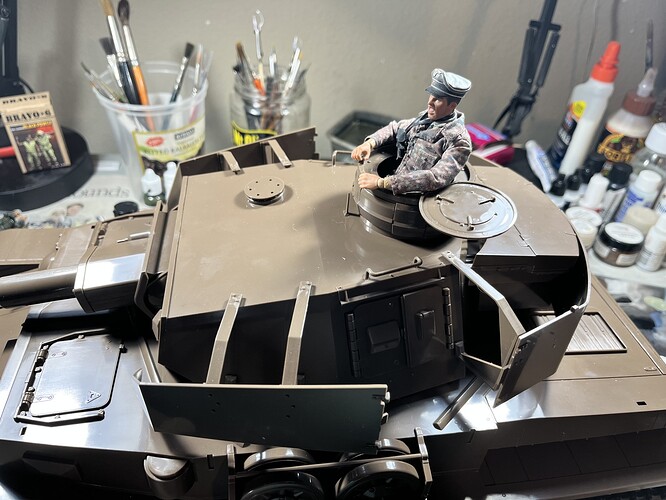I would like some help with a bit of minutiae on the use of Panzer IV AUSF H’s in the summer/early fall of 1944. I have a working knowledge of WWII, but it’s not my prime area of expertise.
I recently purchased a 1:12 scale “Girls Und Panzer” Panzer IV AUSF H for use in toy photography. It’s a beautiful toy/model. I’ll post photos when I can. I’m not a fan of anime girls with firearms, but they Figma “Girls and Guns” makes outstanding models of a huge range of weapons at 1:12 scale, and they made a few tanks as well. Fortunately, there are plenty of high quality 1:12 Germans and GI’s.
I need to paint this monster. It comes mostly pre-built with sections to be assembled. The tank comes with goofy cartoon decals, which won’t work, so I’ll need to print my own.
For my diorama photos, I’m looking to portray tanks that the U.S. 4th Infantry Division would have faced after D-Day. The figures all have standard uniforms and I plan on taking the photos in the spring.
I’m a little unclear on who the 4th would have faced from the Cotentin campaign through the drive into Paris. I see a mish-mash of Wehrmacht and SS units.
My specific questions are this:
- What color(s) should I use? Panzer grey or Dunkelgelb with a camo scheme? Did regular Wehrmacht units use camo paint schemes in France, or were those exclusive to the SS panzers?
- How often would Wehrmacht infantry get support from SS panzers, or vice versa? Many of the 1:12 Germans are SS troops and I can’t tell how often the 4th actually tangled with SS units.
Photos to follow!
1 Like
By that point Dunkelgelb was the factory standard and the ‘H’ was produced after that started; you would likely also see rotbraun and olivgrun applied in various proportions. For that you would go by your period references for the unit you’re interested in.
There should be zimmerit applied if the kit doesn’t have it, and if it has options for certain features you might want to go with the newest features as the ‘H’ actually ended production shortly after D-Day. They switched to the ‘J’ at that time.
2 Likes
You might be able to find some info on the 4th here HyperWar: World War II on the World Wide Web here https://www.lonesentry.com/
Paint can be tricky.
1943 introduced tri-camo; RAL 7028 Dunklgelb (dark yellow), RAL 6003 Olivgrun (olive green), RAL 8017 Rotbrun (red brown). However it (1944) was a transitional period and it could be likely some lesser vehicles and equipment could have been painted in RAL 7021 Dunklegrau (dark grey) and partially overpainted with dark yellow camo pattern.
In August 1944 a new paint scheme was introduced! The only paint changed was the dark yellow. The RAL numer remained the same 7028, however it was designated as Dunklegelb Ausgabe 1944 (dark yellow version 1944).
The 1943-1944 hues all had variances dependent on how the crew camouflaged their vehicles in the field, so I believe artistic licensing is your imagination. The factory painted vehicles after August 1944 were all the same hue.
Looking forward to seeing your diorama.
1 Like
Thanks for the assistance. So If I understand you correctly, the three color camo schemes with Dunkelgelb as the base would have been more or less common among panzer units, and not specific to SS panzers? For the purpose of what I’m doing here, I’m not a stickler on unit markings and colors matching specific known vehicles, but I don’t want to be way off - especially when I make up decals.
The kit does not have zimmerit. Can you direct me to a good method for applying that? I’m sure there are more than a few archived threads on that. As an aside, I’ve always found zimmerit to be fascinating. My understanding is that the Germans were the only ones who used the sort of magnetic mines for which zimmerit would be an effective measure.
1 Like
Regulation H.M. 1943, Nr 181 issued 18 Feb 1943 mandated 3 tone camo with dark yellow as the base, so all German units (SS & Luftwaffe too) were to abide by this. So vehicles coming from the factory after 18 Feb 43 would be painted 3 tone. Previous equipment would be field painted.
So I guess for “accuracy” it would depend what mark designation the vehicles you plan to use were built. So a IV Ausf H would fall in after 1943 so it would have come from the factory painted in 3 tone camo.
Now, lol, each factory painted and zimmerited their vehicles differently. I only have knowledge of this and could not for the life of me tell you what factory did what.
I know squat about zimmerit, however @Armor_Buff knows a thing or two on aftermarket and application.
3 Likes
Pz IV H production and zimmerit application has many variations. Some Pz IV H’s (production start April 1943) didn’t have zimmerit as Zimmerit appears in ~August 1943. The three Pz IV manufacturers (Vomag, Krupp & Nibelungen) have some variations in what was applied even with the vehicles they produced.
This thread discusses some of those variations.
missinglynx: nibelungen-panzer-iv-h-initial-1944-zimmerit
This golden oldie provided a concise overview of German WW2 afv’s:
For discussion only, here’s a snippet for the Pz IV H. My understanding is most of the equipment in Normandy was newer so I believe the vast majority of Pz IV H’s would have zimmerit at that time.
Craig Ellis wrote several Pz IV books that delve into specifics of the manufacturers. Apologies but I’m not enough of an aficionado to accurately summarize the specifics.
Regarding zimmerit application, here’s my favorite way to do 1/35 scale. For a 1/25 scale Panther (long ago), I used part of a razor saw blade & spackle paste. I think with the right blade it would work for 1/12 scale.
HTH
4 Likes
I promised photos. I apologize for the delay. I’m sure that many of you could point out substantial flaws in the details. The hull, hatches, road wheels and treads came pre-assembled. So did the turret, for the most part. The main gun had to be assembled and so does the Schurzen armor. In fact, most of the assembly is in the finer details, such as the additional track links. In fact, the basic kit doesn’t come with the B.I.I. Max Factor made an additional “detail” kit that includes the shovel and other tools that would be secured to tank’s sponsons.
It is meant to be a toy, albeit a collectible, so I’m hoping some additional work will make it more suitable. Painting will be a challenge for me. I usually paint as I assemble, so priming and painting with an 90% assembled model will be new for me.
3 Likes
Is this thing all plastic or is there some die cast to it?
That “Girls und Panzer” brown is an odd color. Before painting or zimmerit, you may need to rough it up a bit, with sandpaper or a scratch pad to give the paint some bite.
1/16 scale decals should work on this (they may be a tad small, but who cares?), and there are lots to be found.
Ken
1 Like
It’s all plastic. That’s a good point; I’ll run some sandpaper over it.
I’ve gotten pretty good results printing my own decals. I’ll probably buy a 1:16 sheet for reference and make bigger copies. We’ll see when I get there.
1 Like
The turret top at least is far too smooth. It is missing a plethora of countersunk screws and weld lines that would be very apparent in this scale, as is the top of the gun mantlet. The engine deck likewise. The track guards should have a dimpled effect, a sort of non-slip surface that was pressed into the metal on the prototypical vehicle and is very noticeable in its absence. There doesn’t appear to be any fitment of “schurtzen” in the photos, these were fitted to all Pz IV at this time and even if lost, their mounting arrangement would still be there. As for units, you are pretty limited, as the majority of the panzer units were deployed against the British sector. On the US side you have 2SS “Das Reich”, 2 PD and “Panzer Lehr” (130 PD). That’s it, apart from “Unternehmen Luttich”, where 116 PD “Windhund” and “LSSAH” were sucked in. 17SS "Gotz v Berlichingen was a panzergrenadier division and did not have tanks, only Sturmgeschutze. Despite SPR, there were no Tigers deployed on the US front, “Das Reich” certainly didn’t have any. “Das Reich” had been rebuilt after the Eastern front campaigns, so all its vehicles were new, units transferred to the West from the East often had to leave all their armoured vehicles behind. “Panzer Lehr” was a recently raised unit, formed from “Lehr” (demonstration) units. It was the best equipped PD in the entire Wehrmacht and Waffen SS and the only one which had all its infantry in armoured half tracks. I personally wouldn’t worry too much about transfers at this scale. Turret numbers painted over Zimmerit in photographs are pretty wobbly (remember they were painted by 18 year olds in the main!), so the best way to duplicate them is to hand paint them! Bear in mind that PzIVs equipped the IInd battalion in nearly all panzer regiments, so company numbering would be 5-8.
3 Likes
The model isn’t completely assembled. I’ll prime and paint many of the external components before proceeding further. I knew someone would inform me of the missing details. 
It’s been damned difficult to figure out which divisions actually faced off against the 4th ID. You might be asking, “why the 4th ID” if I could more easily ascertain which German units fought against other U.S. Divisions. The reason for that is that the 4th was my first unit of assignment (2-8 IN “First at Normandy”!), and I already have 1:12 U.S. figures badged for the 4th.
But it seems plausible enough that I can make a “generic” Panzer IV since I now know that the use of camo paint schemes was universal and not specific to “special” units. I don’t have to worry about “bumper number” accuracy, and I can get a 1:12 Panzer commander. My hang up after this, as mentioned, is that most of the 1:12 figures are packaged as SS men. It’s the cool camo. I can, however, piece together more generic Wehrmacht shutzen.
One more question for the experts, how common was the Stg. 44 in Western Europe? It seems that the Eastern Front received the priority issue of them (like everything). My references provided detailed production numbers, but scarce information on whether Wermacht units in France received very many of them.
1 Like




